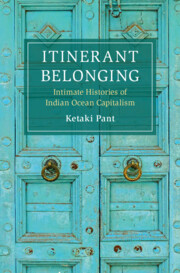Refine search
Actions for selected content:
204 results
Introduction
-
- Book:
- The Indian Ocean and the Historical Imagination in Afro-Asian Fiction
- Published online:
- 19 December 2025
- Print publication:
- 31 January 2026, pp 1-26
-
- Chapter
- Export citation

The Indian Ocean and the Historical Imagination in Afro-Asian Fiction
-
- Published online:
- 19 December 2025
- Print publication:
- 31 January 2026
4 - Role of the Oceans in Southern Hemisphere Climate
-
-
- Book:
- Meteorology and Climate of the Southern Hemisphere
- Published online:
- 10 December 2025
- Print publication:
- 18 December 2025, pp 91-152
-
- Chapter
- Export citation
Reproductive seasonality of Sea Urchin Centrostephanus tenuispinus on high latitude coral and macroalgal reefs in the south-eastern Indian Ocean
-
- Journal:
- Journal of the Marine Biological Association of the United Kingdom / Volume 105 / 2025
- Published online by Cambridge University Press:
- 04 November 2025, e124
-
- Article
-
- You have access
- Open access
- HTML
- Export citation
Circles of Kings and Right of the Port: Maritime Violence and the Galactic Polity in 14th Century Sri Lanka
-
- Journal:
- Itinerario , First View
- Published online by Cambridge University Press:
- 16 October 2025, pp. 1-14
-
- Article
-
- You have access
- Open access
- HTML
- Export citation
6 - Organizing Networks to Supply Mediterranean Markets
-
-
- Book:
- Palmyra, the Mediterranean and Beyond
- Published online:
- 21 October 2025
- Print publication:
- 16 October 2025, pp 127-140
-
- Chapter
- Export citation
Capitalist Flows and Working-Class Conditions: Colonial Labor Management and Racial Formations in Southeastern Africa, 1851–1900
-
- Journal:
- The Journal of African History / Volume 66 / 2025
- Published online by Cambridge University Press:
- 15 October 2025, e21
-
- Article
-
- You have access
- Open access
- HTML
- Export citation
Chapter 37 - Southeast Asia
- from Asia and the Americas
-
-
- Book:
- The Cambridge Guide to Global Medieval Travel Writing
- Published online:
- 03 October 2025
- Print publication:
- 02 October 2025, pp 656-671
-
- Chapter
- Export citation
First report of the genus Codonaria Kofoid & Campbell, 1939 (Tintinnina: Dictyocystidae) from the Indian Ocean
-
- Journal:
- Journal of the Marine Biological Association of the United Kingdom / Volume 105 / 2025
- Published online by Cambridge University Press:
- 12 September 2025, e100
-
- Article
- Export citation
First record of chiroteuthis picteti joubin (cephalopoda: chiroteuthidae) from andaman sea
-
- Journal:
- Journal of the Marine Biological Association of the United Kingdom / Volume 105 / 2025
- Published online by Cambridge University Press:
- 11 August 2025, e87
-
- Article
- Export citation
Observations of the bowmouth guitarfish (Rhina ancylostoma) by-catches by the tropical tuna purse seine fleet in the Indian Ocean’s open waters
-
- Journal:
- Journal of the Marine Biological Association of the United Kingdom / Volume 105 / 2025
- Published online by Cambridge University Press:
- 22 July 2025, e83
-
- Article
- Export citation
A provincial travelogue of the Indian Ocean: chronicling a royal sea voyage in Dhivehi poetry from the Maldives, 1804
-
- Journal:
- Journal of the Royal Asiatic Society / Volume 35 / Issue 3 / July 2025
- Published online by Cambridge University Press:
- 19 August 2025, pp. 561-578
- Print publication:
- July 2025
-
- Article
-
- You have access
- Open access
- HTML
- Export citation
The Politics of Colonial Lists: Conspiracies, Deportations, and Knowledge in 1790s Pondicherry
-
- Journal:
- Comparative Studies in Society and History / Volume 67 / Issue 4 / October 2025
- Published online by Cambridge University Press:
- 24 June 2025, pp. 811-838
-
- Article
-
- You have access
- Open access
- HTML
- Export citation
First genetic and morphological records of Balloon Alfonsin, Beryx mollis egg and larvae
-
- Journal:
- Journal of the Marine Biological Association of the United Kingdom / Volume 105 / 2025
- Published online by Cambridge University Press:
- 22 April 2025, e50
-
- Article
-
- You have access
- Open access
- HTML
- Export citation
1 - Inhabited Histories
-
- Book:
- Itinerant Belonging
- Published online:
- 10 April 2025
- Print publication:
- 17 April 2025, pp 36-74
-
- Chapter
- Export citation
2 - Haunted Houses
-
- Book:
- Itinerant Belonging
- Published online:
- 10 April 2025
- Print publication:
- 17 April 2025, pp 75-115
-
- Chapter
- Export citation
3 - Unsettling Foundations
-
- Book:
- Itinerant Belonging
- Published online:
- 10 April 2025
- Print publication:
- 17 April 2025, pp 116-147
-
- Chapter
- Export citation
Introduction
-
- Book:
- Itinerant Belonging
- Published online:
- 10 April 2025
- Print publication:
- 17 April 2025, pp 4-35
-
- Chapter
- Export citation

Itinerant Belonging
- Intimate Histories of Indian Ocean Capitalism
-
- Published online:
- 10 April 2025
- Print publication:
- 17 April 2025
Cross-cultural Labyrinths in the Literatures of the Indian Ocean
-
- Article
-
- You have access
- Open access
- HTML
- Export citation
